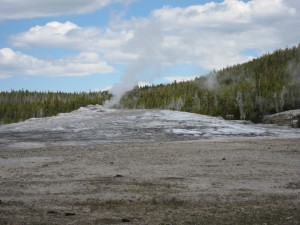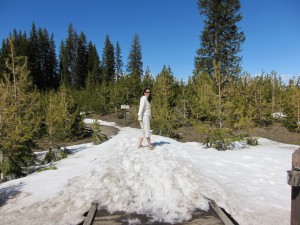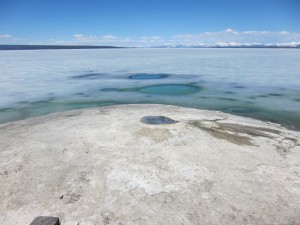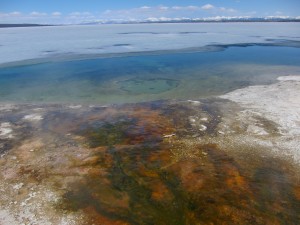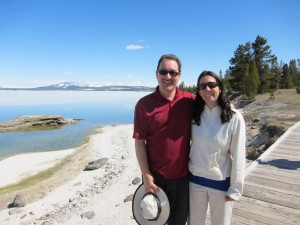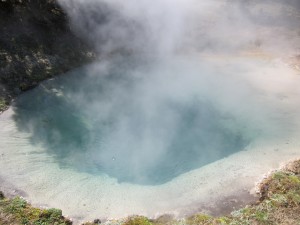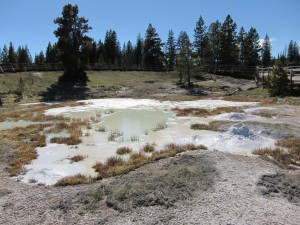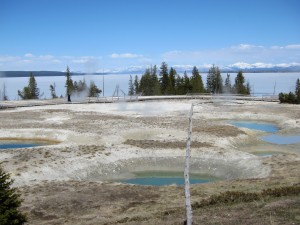This post covers the early afternoon of Friday, May 14, 2010 — Day 21: Yellowstone National Park, Wyoming to Jackson Hole, Wyoming. You can read about the activities we did in the morning here.
We arrived at the Old Faithful Geyser, probably the biggest attraction in the park, around lunch time. As the name indicates, it is a geyser that can be counted on to erupt every 60 to 110 minutes. How long one eruption lasts indicates how long it will be before the next eruption, so a naturalist keeps tabs on the eruptions and posts a sign indicating when they think the next one will occur. It was nice to look at the sign and know we had some time to kill before the next eruption. Instead of sitting outside in the cold, we wandered into the nearby General Store and had lunch.
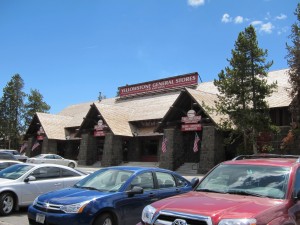 Shortly before the estimated spout time, we found seats in front of the geyser and settled in for the show. The water temperature inside the vent is 204 degrees Fahrenheit, so some steam generally comes out of the geyser most of the time.
Shortly before the estimated spout time, we found seats in front of the geyser and settled in for the show. The water temperature inside the vent is 204 degrees Fahrenheit, so some steam generally comes out of the geyser most of the time.
The steam steadily grew in intensity, then some water started to spout out with the steam:
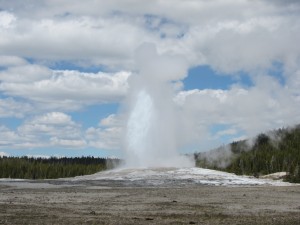 And then she really blew, maintaining this amount of intense pressure for several minutes. We aren’t sure how high the water went, but the range is 106 feet to 180 feet, and the average is 130 feet. We’d say 130 feet was a reasonable estimation. Between 3,700 and 8,400 gallons of water are expelled per eruption.
And then she really blew, maintaining this amount of intense pressure for several minutes. We aren’t sure how high the water went, but the range is 106 feet to 180 feet, and the average is 130 feet. We’d say 130 feet was a reasonable estimation. Between 3,700 and 8,400 gallons of water are expelled per eruption.
 When we planned this trip, we had carefully mapped out an aggressive route that would get us across the country and back in three weeks. There was no room in the itinerary for delays or major detours. As we mentioned in the last post, it never occurred to us that snow would be an issue so late in the year; we were shocked to find most of the roads in Yellowstone were still closed due to snow. In order to keep to our intended route, we needed to leave the park today via the south exit. Much to our astonishment, they opened the south road today! We were amazed by our good fortune. We hopped into the car and onto the south road, stopping at several sites along the way out.
When we planned this trip, we had carefully mapped out an aggressive route that would get us across the country and back in three weeks. There was no room in the itinerary for delays or major detours. As we mentioned in the last post, it never occurred to us that snow would be an issue so late in the year; we were shocked to find most of the roads in Yellowstone were still closed due to snow. In order to keep to our intended route, we needed to leave the park today via the south exit. Much to our astonishment, they opened the south road today! We were amazed by our good fortune. We hopped into the car and onto the south road, stopping at several sites along the way out.
The first stop was at the Black Sand Basin, located in the Upper Geyser Basin, another walking trail that makes a 1/4 mile loop. The area gets its name from black obsidian (volcanic glass) sand, and has several unique thermal attractions:
1. Spouter Geyser: Erupts for 10 – 11 hours at a time, stops for 1 to 2 hours, then spouts again. The spouts range from 5 – 7 feet; water temperature is 200 degrees Fahrenheit. There was a little bubbling mud pool next to it, but since the sign didn’t mention the mud pool, we are guessing it probably dries up after the snow melt ends.
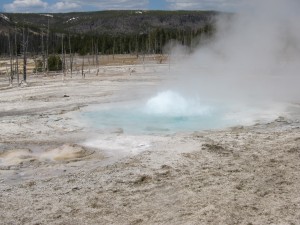 2. Cliff Geyser is located on the edge of Iron Creek, and goes off at irregular intervals. Though there are usually one or two eruptions a day, there may be weeks or even years of dormancy. An indication of a pending eruption is that the crater nearly fills with boiling water. As the eruption begins, jets of water and steam explode through the pool 15 to 40 feet high. The spout can last from 30 minutes to 3 hours, though the height peaks the first half hour and gradually subsides until the crater empties.
2. Cliff Geyser is located on the edge of Iron Creek, and goes off at irregular intervals. Though there are usually one or two eruptions a day, there may be weeks or even years of dormancy. An indication of a pending eruption is that the crater nearly fills with boiling water. As the eruption begins, jets of water and steam explode through the pool 15 to 40 feet high. The spout can last from 30 minutes to 3 hours, though the height peaks the first half hour and gradually subsides until the crater empties.
3. Green Spring had no information posted.
4. Emerald Pool is only 154 degrees Fahrenheit, so certain algae can live in this water but not the hotter springs and pools. That is why this pool is green and most of the others are blue.
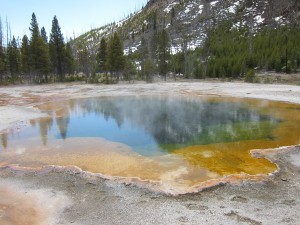 5. Rainbow Pool is actually a geyser that doesn’t erupt very often — the last one was in 1973. It got its name because the bacteria mat around the edges is supposedly brilliantly rainbow colored. We must have picked a bad day because the ring just looked mostly yellow to us.
5. Rainbow Pool is actually a geyser that doesn’t erupt very often — the last one was in 1973. It got its name because the bacteria mat around the edges is supposedly brilliantly rainbow colored. We must have picked a bad day because the ring just looked mostly yellow to us.
 6. Sunset Lake got its name from the yellow and orange bacteria mat around the edges. It is also a rarely active geyser; when it does erupt, the water reaches 3 – 8 feet high. Mostly the water that bubbles up overflows the edges and runs down to Rainbow Pool. Forgive the oddly angled photo. It is of the edge of the lake and a little bit of a runoff channel. It lets you see some of the bright blue middle along with the algae mat.
6. Sunset Lake got its name from the yellow and orange bacteria mat around the edges. It is also a rarely active geyser; when it does erupt, the water reaches 3 – 8 feet high. Mostly the water that bubbles up overflows the edges and runs down to Rainbow Pool. Forgive the oddly angled photo. It is of the edge of the lake and a little bit of a runoff channel. It lets you see some of the bright blue middle along with the algae mat.
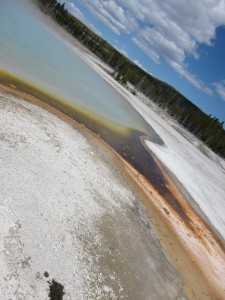 We hopped back in the car and continued south. We’ve seen lots of buffalo on the road today, but this was an especially good photo:
We hopped back in the car and continued south. We’ve seen lots of buffalo on the road today, but this was an especially good photo:
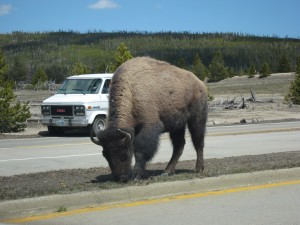 The next stop was Kepler Cascades, a waterfall on the Firehole River. There are multiple drops, the longest being 50 feet, with a total drop of approximately 125 feet. As you can see, the trail up was snowy, but fortunately, it wasn’t a long walk.
The next stop was Kepler Cascades, a waterfall on the Firehole River. There are multiple drops, the longest being 50 feet, with a total drop of approximately 125 feet. As you can see, the trail up was snowy, but fortunately, it wasn’t a long walk.
 Our next stop was West Thumb Geyser Basin, a thumb-like projection off Yellowstone Lake. 125,000 years ago, a massive explosion created a caldera along the edge of the lake. The water is deeper here than the rest of the lake, with warm pockets year round, and the shoreline has a wide variety of thermal features. Since the mid 1970s, some temperatures within West Thumb have cooled and thermal activity has decreased. There are two waking trails here, both loops, one 1/4 mile and the other 1/2 mile. We were surprised at all there was to see here. Here are some of the highlights.
Our next stop was West Thumb Geyser Basin, a thumb-like projection off Yellowstone Lake. 125,000 years ago, a massive explosion created a caldera along the edge of the lake. The water is deeper here than the rest of the lake, with warm pockets year round, and the shoreline has a wide variety of thermal features. Since the mid 1970s, some temperatures within West Thumb have cooled and thermal activity has decreased. There are two waking trails here, both loops, one 1/4 mile and the other 1/2 mile. We were surprised at all there was to see here. Here are some of the highlights.
1. Abyss Pool is is the deepest pool known in Yellowstone and received its name for its abyss-like depth (53 feet). Coins and other debris thrown in have caused the vent to plug, reducing spring flow and the pool temperature (now 172°F), allowing abundant algae growth along the edge and run-off channels.
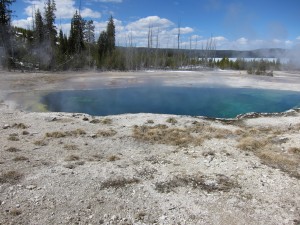 2. Black Pool is surrounded by orange-colored microbial mats, which grow abundantly in the low temperature (132°F) of the pool.
2. Black Pool is surrounded by orange-colored microbial mats, which grow abundantly in the low temperature (132°F) of the pool.
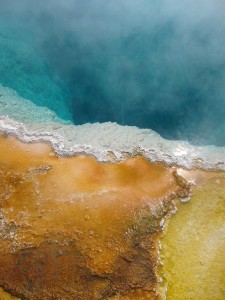 3. Big Cone — you have to look carefully at this picture to see it. In the foreground is a white earthen mound with a small opening in it. Behind the cone is the frozen lake with a few small melted spots. No information was posted on the sign.
3. Big Cone — you have to look carefully at this picture to see it. In the foreground is a white earthen mound with a small opening in it. Behind the cone is the frozen lake with a few small melted spots. No information was posted on the sign.
4. Fishing Cone is situated on the shore of Yellowstone Lake. Fishermen used to stand on the cone and cast their lines into the lake to catch fish. Without taking the fish off the hook they parboiled them in the vent of Fishing Cone. The shoreline has changed since those times and now Fishing Cone is usually inundated by high water during the early summer. The cold water of the lake seems to have rendered the cone dormant. But as you can see in the photo, steam still rises from it and the heat from the cone has created a melted area in the middle of the otherwise frozen lake.The second shot gives you an idea of how large the warm spot is.
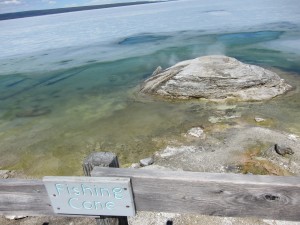
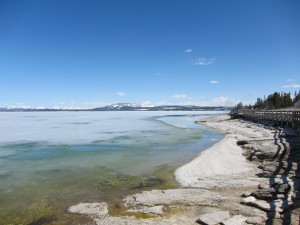 5. Lakeshore Geyser is also right on the lake’s shore. It has 198.6°F water inside and goes off at irregular intervals. The eruptions last 10 minutes and are 20 – 30 feet high. Sadly, it didn’t perform for us.
5. Lakeshore Geyser is also right on the lake’s shore. It has 198.6°F water inside and goes off at irregular intervals. The eruptions last 10 minutes and are 20 – 30 feet high. Sadly, it didn’t perform for us.
Another hot pool (and we are guessing geyser) along the edge of the lake with no sign. We are guessing the funnel in the first photo is where the water comes out. The second photo is of us next to the same hot spot a little farther down the walkway.
This was an unmarked algae mat.
Bluebell Pool had no information on the sign. These two pools were side by side, so we aren’t sure which one is bluebell or if they both comprise bluebell.
Thumb Paint Pots apparently used to be thicker, like the Fountain Paint Pots in the Lower Geyser Basin, but since the thermal shift in the 70s more water collects in there, making it almost a spring. On the right edge of the mud you can see the pots were bubbling — the cones are from the thermal activity .
Ledge Spring had no information on the sign.
Perforated Pool had no information on the sign.
No sign on this one, but we like this shot because you can see the frozen lake behind the hot pools, which emphasizes the temperature differential.
Since this post has gotten ridiculously long, we’ll stop here. In a few days, we’ll put up another post completing Friday, May 14, 2010 — Day 21: Yellowstone National Park, Wyoming to Jackson Hole, Wyoming.
This is Part 17 of the Passage Across America series. Read Part 16 here and Part 18 here.

